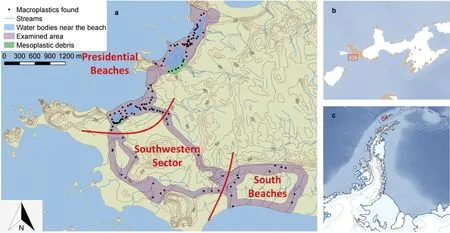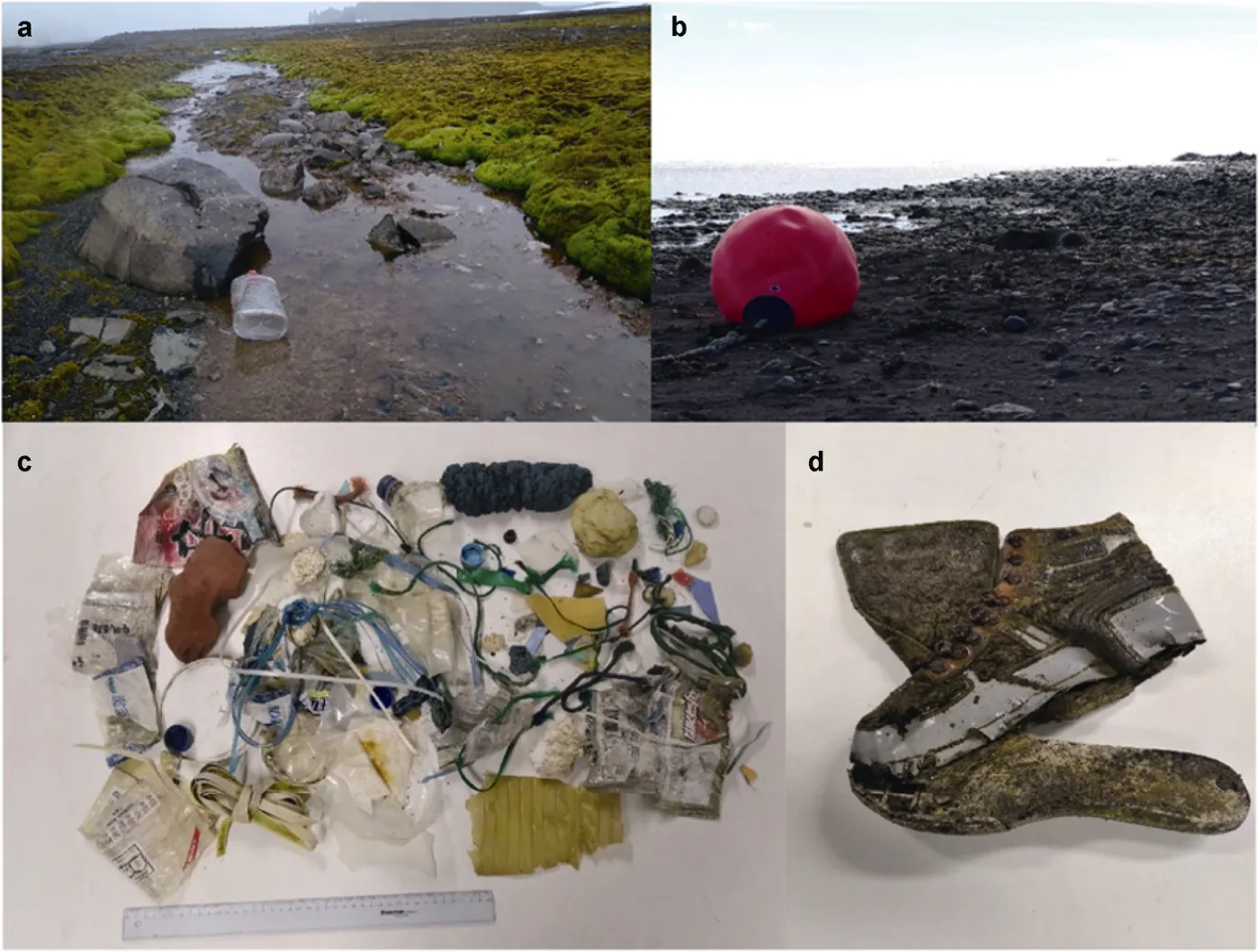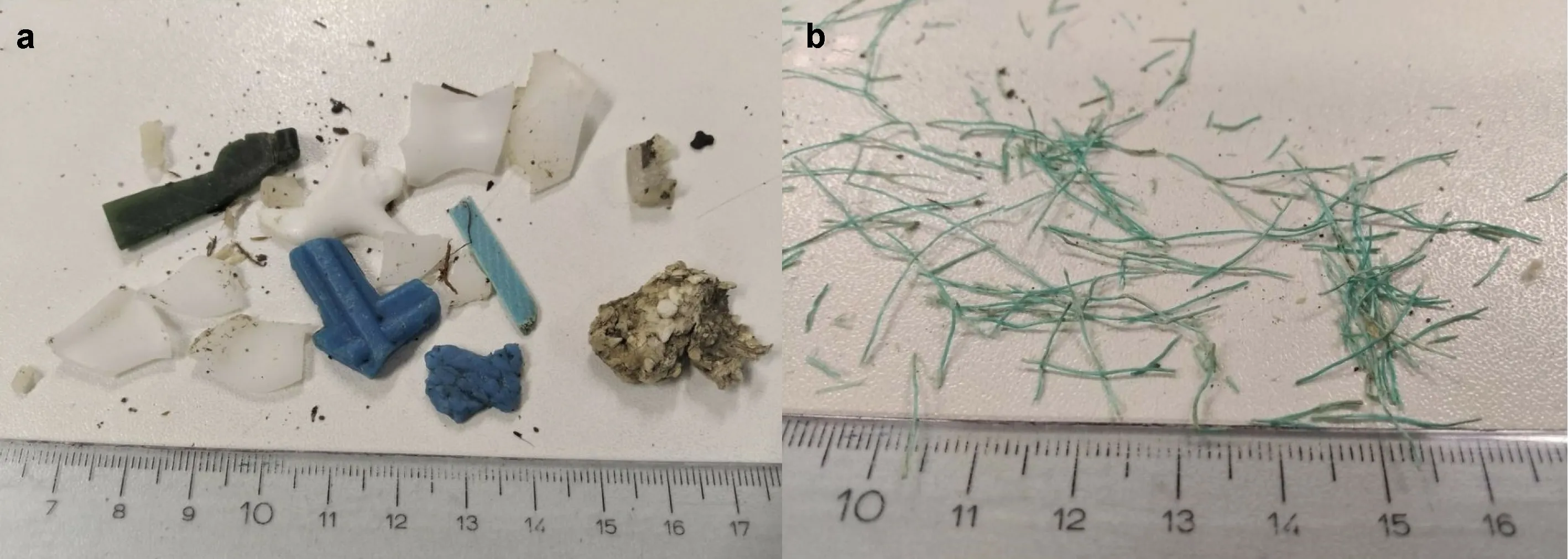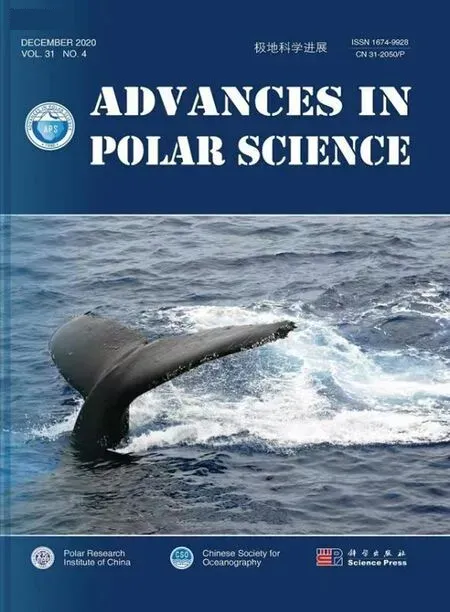Are Antarctic Specially Protected Areas safe from plastic pollution? a survey of plastic litter at Byers Peninsula,Livingston Island,Antarctica
2020-04-12PabloALMELASergiGONZALEZ
Pablo ALMELA &Sergi GONZALEZ
1 Biology Department,Autonomous University of Madrid,Madrid,Spain;
2 Antarctic Group,Spanish Meteorological Service (AEMET),Barcelona,Spain
Abstract A number of studies have reported in the last decades the presence of plastics in the Southern Ocean,which are liable to reach the coast and accumulate on the Antarctic Continent.Despite this,there are few data on the amount of plastic pollution on Antarctic beaches below 60°S.Here we provide valuable information about the presence of plastic debris in Byers Peninsula,Livingston Island,South Shetland Islands,an Antarctic Specially Protected Area (ASPA) and a hotspot for biodiversity.A total of 129 locations with between 1 and 5 items were recorded among the 3 survey sites on Byers Peninsula.Most of the observed items are likely to derive from fishing and local sources such as tourism and research activities.We discuss the potential impacts of their presence on local fauna and some of the consequences on the Antarctic ecosystem.From this survey of plastic accumulation in an ASPA,we propose the implementation of mitigation strategies,such as systematic monitoring of the abundance and distribution of plastic waste,in order to identify trends in marine debris and control the levels of plastic pollution in the Maritime Antarctic region.
Keywords marine debris,plastic pollution,human impact,Antarctic Specially Protected Area (ASPA),management,Antarctica
1 Introduction
Plastic debris is ubiquitous in the environment and virtually no place on earth can be considered immune from plastic pollution (Barnes et al.,2003).Despite the widespread recognition,the problem is still growing and even if stopped immediately,it will persist for centuries (Windsor et al.,2019).Worldwide plastic production amounted to 380×106t in 2015 (Geyer et al.,2017).For that year,it was calculated that 47% of plastic waste was discarded or landfilled (Lebreton and Andrady,2019),and only 18% was recycled (Zheng and Suh,2019).Estimates predict that 3.1×106–8.2×106t end up in the oceans every year (Jambeck et al.,2015;Lebreton and Andrady,2019).It has been suggested that most of these plastics finally accumulate in the deep-sea sediments (Woodall et al.,2014).However,the remainder are susceptible to traveling long distances by sea currents and can accumulate far away from where they were discarded (Ryan et al.,2009).
Many published studies show the presence of plastics along beaches from almost any part of the world (e.g.McDermid and McMullen,2004;Heo et al.,2013),even in the Arctic region (Bergmann et al.,2017;Halsband and Herzke,2019;Kylin,2020).However,only few surveys of litter accumulation in Antarctic beaches have been conducted prior 2020 (e.g.Gregory et al.,1984;Torres et al.,1997;Barner and Fraser,2003;Waluda et al.,2020),considering it isolated from the rest of the planet because of the Antarctic Circumpolar Current (ACC).The ACC acts as a natural barrier encircling Antarctica,producing a minimal exchange of seawater from north to south.But recently,several reports have been published on the presence of plastics in the Southern Ocean (Isobe et al.,2017;Waller et al.,2017;Lacerda et al.,2019;Anfuso et al.,2020;Jones-Williams et al.,2020) and in the islands of the Scotia Sea (Convey et al.,2002;Monteiro et al.,2018;Waluda et al.,2020).These data suggest that the marine transport of plastics is not totally restricted by the ACC,despite the reduction in plastic concentration is notable (Suaria et al.,2020).This confirms that Antarctica is not an isolated continent (Chown et al.,2015;Fraser et al.,2018),and it is affected by plastic pollution to an unknown degree.
To help fill in this information gap on plastic pollution,here we report the accumulation of meso and macroplastics debris on two Antarctic beaches located on Byers Peninsula,the Antarctic Specially Protected Area (ASPA) 126.These data may serve as a baseline for future and more systematic studies that will increase our understanding of plastic pollution and its ecological impact on remote protected areas.
2 Study area
Byers Peninsula (62°38′S,60°5′W;Livingston Island,South Shetlands Islands,Antarctica) is the ASPA No.126,originally classified as Specially Protected Area (SPA) No.10 in 1966,designated in 2002 to protect terrestrial and lacustrine habitats,as one of the main Antarctic hotspots of biodiversity (Secretariat of the Antarctic Treaty,2011).The site is recognised as an Important Bird Area (IBA) because it supports breeding colonies of Antarctic terns (Sterna vittata) and kelp gulls (Larus dominicanus),among other avian breeders.In addition,large numbers of southern elephant seals (Mirounga leonina) haul out during their breeding season.Smaller,but no less important,are microbial mat communities,extremely abundant on Byers Peninsula and considered as essential to our understanding of the diversity,the community structure and dynamics of these ecosystems (Almela et al.,2019).For these characteristics,Byers Peninsula is a key observing spot to monitor the effects of climate change on freshwater and terrestrial ecosystems (Quesada et al.,2009).Recent activities within the area have been almost exclusively for scientific research,and in accordance with a permit issued by a competent national authority.Therefore,the area has remained largely unaffected by direct human disturbance,compared to other areas in the vicinity which are visited more regularly.
The survey was conducted in the southwestern side of the island.We carry out several transects covering a relevant part of President Beaches and South Beaches,and a sector that separates both beaches.The surveyed soils are composed mainly by sandy soils (0.05–2.0 mm) with a small fraction of clay and silt (<0.05 mm) (Navas et al.,2006).This allows the identification of meso and macroplastics in the field (Chubarenko et al.,2018).Presidential beaches are 300–500 m wide and are located at the Osogovo Bay with a WNW orientation.The bay is protected by Rugged Island in the NW,by Vardim Rocks in the SE,and by Astor Island and Dospey Heights in the N.Therefore,only drifting material coming from the W or crossing the strait east of Rugged Island can reach the beach.In contrast,South Beaches,which are orientated towards the S,are 700 m wide and present an open coastline and can potentially accumulate material adrift from the SW to the SE.The Southwestern Sector is more irregular and extends from lowlands near the beaches to the elevated plateau.In this sector,the beaches were not surveyed.
3 Methods
The survey was conducted at Byers Peninsula in February 2019 by two people during 3 days,totalizing 16.3 km.The strategy used to examine the beaches was to carry out two transects,one near the sea line and the other inland at the end of the beach.Transects were opportunistic,that is,we took advantage of our scientific plan to scour and clean up the beaches.When a plastic item was spotted (limited to macroplastics,>10 mm),the GPS position was annotated.All the plastic pieces around the area within a 10 m radius were considered to be in the same location.Whenever possible due to its dimensions,we removed the plastic piece to clean-up the peninsula.Plastic materials found were visually analysed when possible to identify its composition,country of manufacture and infer their potential functionality.The plastic size criterion was applied accordingly to Hartmann et al.(2019).Therefore,items of 1 mm to<10 mm in size were classified as mesoplastics,and items larger than 1 cm as macroplastics.Pictures of the most representative items found along the transects were taken.
4 Results and discussion
A total of 16.3 km between the two transects was surveyed and 129 locations with plastic litter were annotated (Table 1).They are mapped in Figure 1a and photographs of the most representative plastic items (Figure 2) can be found at https://www.flickr.com/photos/plasticsbyers/.In general,we sampled 1-to-5 items of plastic litter per location,except in few locations where tens of mesoplastics pieces accumulated.Our study reveals the presence of a considerable amount of plastics at Byers Peninsula.President Beaches concentrates most of the plastic litter with 15.0 locations per km corresponding to a range between 15–75 macroplastic items.On the contrary,South Beaches are relatively free of plastics with only 3.0 locations per km (3–15 items·km-1).The Southwestern Sector have a similar density to South Beaches with 3.4 locations per km (3.4–17 items·km-1).If we compare our results of macroplastic litter with those reported from other remote regions of the globe (Lavers and Bond,2017),even with those from sub-Antarctic islands reviewed in do Sul et al.(2011),the beached debris densities found are relatively low.The differences between the amount of plastic debris on President and South Beaches are considerable.Accumulation rates of plastic items at beaches are dependent on ocean currents,tide and onshore winds,among other factors (Eriksson et al.,2013).Therefore,the likely explanation for this difference between spatial distribution and plastic locations is that these elements are drifting material and are more likely to reach the beaches on the west coast of the island,such as President Beaches (Fraser et al.,2018),as observed in other studies in the Southern Ocean (Monteiro et al.,2018;Waluda et al.,2020).Indeed,most of the plastics accumulate near the coast.However,we also found many plastics in streams and water bodies.Litter accumulated in the water bodies is probably also washed away by the sea and trapped by the wetland (Yao et al.,2019),since it is unlikely that large debris would derive from the seasonal streams coming from the inner Antarctic Peninsula region,as reported by Lebreton and Andrady (2019) from other regions.

Table 1 Length of the transects,number of locations with macroplastics and density of plastics examined.Plastic locations included 1-to-5 plastic items

Figure 1 Presence of plastic debris on south-western Byers Peninsula (Livingston Island,Antarctica),an Antarctic Specially Protected Area and a hotspot for biodiversity.a,Plastics observed during the transects within the approximately examined area (violet shaded),position of plastics debris (black dots),and areas where small debris,mostly mesoplastics,were found (green shaded);b,Map of Livingston Island;c,Map of the Antarctic Peninsula with the relative location of the area examined.

Figure 2 Examples of plastics found on the field:a,PET bottle;b,a buoy stranded next to an elephant seal;c,different macro-plastic debris;d,a plastic boot.More images can be found at https://www.flickr.com/photos/plasticsbyers/.
Most of the plastic items found correspond to bottles,packaging bands,bags,remnants of fishing gear,strips and bottle caps.Seven buoys (>50 cm in diameter) were found stranded at President Beaches,and one in the Southwestern Sector,which was about 500 m from the sea.No buoys were found on Southern Beaches.We also found many particles of expanded polystyrene (EPS) that is recognized in the Antarctic Treaty System as a risk to wildlife and listed in the Madrid Protocol as prohibited material (Riddle,2009).EPS fragments were found in all surveyed areas.Some items were in such a high degree of degradation that they fragmented as we collected them,showing the long time spent in the environment.Therefore,objects found suggest that the arrival of plastics items on the coast of Byers has been occurring for a long time.From those plastic items that could be identified,we estimate that most of them were made of polyethylene,similar to the most reported material of the drifting items of the Southern Ocean (Suaria et al.,2020).This indicates that remote areas such as Byers Peninsula may be a potential sink for marine debris.
We also reported two large sandy areas,both at President Beaches,where smaller debris (mesoplastics and macroplastics<3 cm) accumulated (Figure 3).In these areas (green shaded in Figure 1a),the concentration of plastic fragments was estimated in tens of items per square meter.All mesoplastic particles were fragments of larger materials and no pellets were found.These areas coincide with the parts of the beaches that are most protected from the waves and strong winds.But also,the local fauna is more abundant here.In fact,the southernmost reported region corresponds with a breeding area of Gentoo Penguin (Pygoscelis papua),with a colony of about 3000 nests (Emslie et al.,2011).Penguins are susceptible to eat small plastic items and has already been reported in Georgia penguin guano (Bessa et al.,2019;Le Guen et al.,2020).Although we assume that the ingestion of plastic by penguins mainly occurs at sea,debris stranded on the beach suggest that its presence could extend offshore into the bay.The ingestion of micro-and mesoplastics can cause mechanical damage to marine organisms (Li et al.,2018),especially to seabirds (Wilcox et al.,2015).However,a very different presence of microplastics has been observed in the studied food webs of Antarctica.There is strong evidence that microplastics have penetrated deep into the soil food web,as suggested by the presence of micro-sized EPS in the common Antarctic collembola (Cryptopygus antarcticus) (Bergami et al.,2020).In contrast,a very low incidence has been observed in the pelagic food web of the Bransfield Strait,from the analysis of Antarctic fur seals scats (Arctocephalus gazella) (Garcia-Garin et al.,2020).Recently,it also has been reported the presence of microplastics on freshwater on this ASPA (González-Pleiter et al.,2020).Therefore,the presence of multiple EPS fragments in the area,as our monitoring activities have shown,and the probably related presence of microplastics,show the risk to which the area’s terrestrial diversity is subjected.Another risk factor associated to plastic debris in the marine environment is the leaching of plastics additives (Avio et al.,2017) or its potential role in the spread of microbial pathogens that could affect wildlife (Lamb et al.,2018).

Figure 3 Examples of macro (a) and mesoplastics (b) found on the field.
The origin of the plastic items can be discussed based on their potential functionality and by the country of manufacture.We can infer whether they come from local activity within the ASPA or from regional or global activity.Despite the difficulty in ascertaining the origin of most of them,products manufactured in Argentina,Australia,Brazil,Chile,China,Japan,Spain and Uruguay were identified.However,it is uncertain if the release of the plastic items to the environment comes from the country of origin,from the tourist ships or from the scientific stations of the region.We found three items directly related with scientific activity on the Southern Beaches.This is a very small proportion,considering that it is the only activity allowed in the island.Fishing gear remains,nautical ropes and buoys were abundant items found in this study (Figure 2).Considering the potential functionality of these plastic items,it seems reasonable to think that a large proportion of the items found comes from the fishing activity and other maritime activities.This agrees with the results of previous authors in the Southern Ocean (e.g.Waller et al.,2017;Suaria et al.,2020),and indicates that fishing activity has a high impact even on most valuable terrestrial ecosystems.Finally,we also identified a few fragments related to the incineration of vessels garbage,as already reported by Torres et al.(1997).This indicates that secondary products of the management of plastic waste,can be found on beaches located south of latitude 60°S.Therefore,vessel incineration does not completely prevent the contamination of the Antarctic environment.An increase in maritime activities,as seen in tourism activity,which in the last two years increased by 43% (IAATO,2020),may represent a threat to the sustainability of the Antarctic ecosystem in the absence of more severe measures to limit plastic contamination.
Plastic debris are often released into the environment by accident during the Antarctic activities.Therefore,the implementation of preventative strategies,such as gear tagging and tracking,is not enough and remediation strategies are needed (Eriksen et al.,2020).Some of these measures may include the implementation of less durable and degradable fishing gear,the use of “eco-friendly” scientific material,and incentives for the recovery of plastic garbage not only in the sea (Lofoten and Havas,2017),but also on the beaches.Current monitoring efforts to collect baseline data will be an integral part of evaluating the effectiveness of any mitigation.Thus,the implementation of systematic monitoring,especially on the ASPA areas,will provide us with specific information on the sources of plastic contamination and the information obtained will help to establish the proper policies to ensure environmental conservation.
5 Conclusions
The data reported in this article indicates that coastal ASPAs are not isolated from plastic pollution.Although some plastics may accidentally be lost from scientific activities on the field,the major threat comes from plastics that are transported by the sea.Despite the low concentration of floating plastics found in the Southern Ocean (Suaria et al.,2020),some Antarctic beaches,particularly those located at the west and north side of the islands,act as accumulation areas.By their condition of protection and isolation,coastal ASPAs are key areas to monitor the reach of the drifting plastics to the land in Antarctica.The clean-up of the beaches provides the opportunity to calculate the rate of accumulation of debris at the coast as is currently being done in sub-Antarctic islands (Waluda et al.,2020).We propose the implementation of remedial strategies,in addition to systematic monitoring on Byers and other ASPAs in order to identify trends in Antarctic marine debris and control the levels of plastic pollution in the region.
Undoubtedly,many more studies are needed to understand the consequences of plastic accumulation and its effects on the ecosystem.However,this supported data raises the question of whether those areas of greatest biological interest in the most pristine place on the planet,Antarctica,are really protected and preserved for future.
AcknowledgmentsWe thank to MICROAIRPOLAR project for giving us the opportunity to participate in this Antarctic campaign,and to members of the Marine Technology Unit (UTM-CSIC) who gave us support on the field,especially to David Hita.We acknowledge the Norwegian Polar Institute’s Quantarctica package.This work was supported by the Spanish Agencia Estatal de Investigación (AEI),Grant no.CTM2016-79741-R.PA is supported by a FPI-contract fellowship (Grant no.BES-2017 080558) from Spanish Ministerio de Economia y Competividad (MINECO).SG is supported by research group 2017-SGR-1102 from the Catalan Government and by the AEMET Antarctic Program from MINECO.This article has been benefited significantly from the constructive comments received from three anonymous reviewers,and Ian Allison as one of Editors-in-Chief.We sincerely thank them for their useful insights.
杂志排行
Advances in Polar Science的其它文章
- Contents of Volume 31,2020
- Evaluation of the Polar Code in different environments and for different maritime activities in the two polar regions
- Large spread across AeroCom Phase II models in simulating black carbon in melting snow over Arctic sea ice
- Air pollutants and greenhouse gases emission inventory for power plants in the Antarctic
- Installing a prototype wind turbine to produce energy in Antarctica to allow a permanent Colombian scientific base to be established
- Approximating home ranges of humpback and fin whales in Drake Passage and Antarctica
